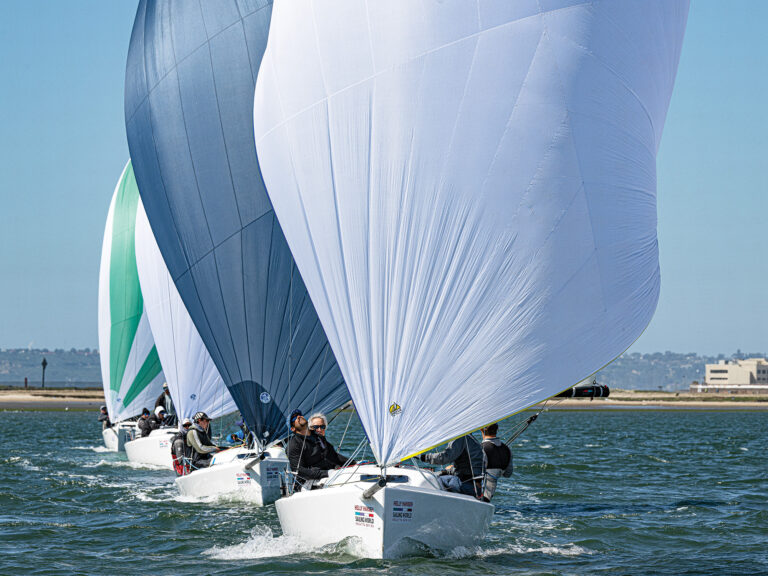
headsail game 368
A good headsail trimmer will take ownership of all the jibs in a boat’s sail inventory, making sure that whether they’re flying or not, each sail is being used to the maximum advantage of the team, and is cared for as well as possible. By overseeing the headsail inventory, the trimmer also gives his or her tactician and skipper one less thing to worry about.
Start at the dock
Preparing the boat’s headsail inventory for a day’s racing may seem straightforward-load the sails onto the boat and go. But there are a few nuances that could make the difference between winning and losing a regatta.
We all grew up folding jibs down the luff. This could be because bowmen are often the most vocal and demanding guys on the boat, and having the luff flaked underneath the headfoil makes hoisting the jib a lot easier and faster. The downside of the luff-flake, however, is that the sail cannot be bricked to a manageable size. This isn’t an issue on bigger race boats with open interiors, a TP52 for example, because headsails can be laid out lengthwise inside the boat. In this case, a luff-flake is preferable. However, on smaller boats or boats with limited interior space-whether it’s a Farr 40 or a racer/cruiser with a full interior-by flaking down the leech, the battens stack on top of one another, which allows the crew to fold the jib into thirds after zippering the bag. The key to a good leech flake is for whoever’s tending the leech to take a big “cheater flake” (folding the clew under, which automatically creates the first flake at the leech) before any folds are done in concert with the person tending the luff.
Once the sail is folded into thirds, it’s much easier to store down below, is less likely to be damaged when being pulled out of a small hatch, and allows you to concentrate the weight of the sails down below-usually this means as much over the keel as possible.
Loading the boat
Efficient stacking of sails will make sail changes faster and reduce wear and tear. Once your headsails are prepared, it is time to load the boat. Before you start this process, read a forecast for the day. Knowing what conditions to expect is critical when loading the boat. Some boats will carry four or more headsails for a day of racing. You’ll want to make sure that the most likely headsails are readily accessible, while the ones least likely to be used are positioned where their weight will prove most advantageous.
When positioning your sails, consider anything that makes one place easier to access a sail than another. Does one side of your interior have easier access than the other? On the Quantum Racing TP52, the mast bulkhead has a cutout on the port side allowing access from the back of the boat to the forward hatch. For this reason we load the most likely headsails on the port side of the cabin. The easier it is to pull a headsail from the cabin, the less likely you are to damage it in the process. Another thing to consider is foot traffic through the cabin during racing. Walking or standing on a folded headsail does as much damage as using it. In fact, on the Farr 40 Barking Mad, we track not only how many legs each sail does over its lifetime, but also how many regattas it was onboard, even if it was not used. Sails that have done very few legs of racing may still look old because they were abused down below. When storing your sails, consider whether they lie, for example, along the path of the sewer person as he runs forward to pull down the spinnaker, near the on or off switch for the engine, or over the thru-hull windows used to check the foils for weed.
Keep the weight of the headsails as low as possible to increase the boat’s stability. Spread them out evenly from side-side, and if you have an odd number of headsails, stack the odd one on the starboard side so that you have the best possible stability out of the start. Avoid stacking the sails in bunks or other elevated areas. This may require compromising the goal of keeping the sails out from underfoot. You know your boat best, but the ideal situation is having the sails low and not being trampled.
You may think of your headsails as waterproof, but don’t underestimate the negative effects of getting them wet: once wet, they’re heavier, harder to hoist, and more likely to contribute to the boat’s heeling. Also, a salty sail will remain wet for longer than one that is not.
Finally, make sure the headsails are not going to foul any of the lines that are down below. On the Farr 40, whenever we move a headsail we pull out any lines led through the cockpit windows and drop the tails back down so we know they are on top of the headsail stack. On the TP52, we have to check that the headsails do not interfere with the traveler system in the back of the boat. I’ve heard of boats where the headsails have interfered with rudder cables and bound up the helm.
Changing before the start
No matter how or when you’re changing a headsail, the first step is always the same: pull the new one out from down below. This applies even if the other sail is on deck, neatly flaked in its bag. Whether the new sail comes out the companionway or the forward hatch depends upon the boat. If you take a luff-flaked headsail out of the front hatch, be careful not to let the sail fold unnaturally on its way out. This could result in a broken batten or two.
If you have time, make sure to run the zipper on the bag. The most effective way to do this is have one person appointed the sailbag minister. It doesn’t have to, and probably shouldn’t, be the jib trimmer, who’ll be busy setting up the new headsail. But one person should be in charge of ensuring the zipper is at the proper end-ready to bag the sail when necessary-and folding the bag to go down below.
The best way to fold the bag is to start at the back end and roll it, stopping at the forward zipper, and then stuffing the roll into the forward end of the bag. This creates a portable package that can be quickly thrown forward for a last-minute change.
Changing during a race
The process is similar for changing sails during a race. The difference is usually time-the lack of it-and the pressure of sailing the boat as fast as possible while making the change. These two things make everything a lot more difficult.
As with any other big decision made during a race, there should be a core group of people to decide on the proper headsail for the next beat. On the boats I sail, it’s usually the skipper, tactician, mainsail trimmer, and, of course, the headsail trimmer. However, the ultimate decision should always come from one person-and the same person every time. That job usually falls to the headsail trimmer.
As soon as you have settled onto the downwind leg, start thinking about which headsail you will want on the next upwind. Look upwind, check the wind speed, try and mentally check against the forecast: is the wind going to build or die?
Ideally, every headsail change would result in the old sail being packed into its bag before being shuffled below. If you know a sail change is likely, ask the bow team to bag the sail during the run, just in case.
In some cases, however, the final headsail decision may need to wait as long as possible to avoid choosing the wrong sail. Or maybe the weather changes dramatically late in the run. Sail enough races and you’re bound to have a few frantic headsail changes. If you don’t have enough time to properly fold and bag a headsail-it’s a good idea to know how long it takes your crew to do a change-you have two choices. If the next leg is the last leg of the race, you may choose to stuff it below as quickly as possible. It’s fast, but messy and may preclude using that sail again without packing it first.
If you’re doing a point-to-point race, or you have more than one upwind leg to go, a compromise is to luff-tie the sail. This will take a little longer than stuffing it, but a lot less time than a pack. To do this, the bowman does a quick luff-flake, and then throws a sail-tie around the forward edge of the sail. The headsail is then stuffed below. If it’s done right, this sail should be usable again without too much difficulty.
The Pack Bag
On the TP52 Quantum Racing, we looked at ways to speed up our packing techniques to allow ourselves more time make the correct sail choice and to keep the stuffing of sails to a minimum. Since we’re limited in our sail purchases for the Audi MedCup circuit, it’s very important each sail last as long as possible. Nothing beats up a sail like stuffing it below without folding and bagging it first. So we added a specialty pack bag to our inventory. This bag is constructed of very light materials and is 20-percent longer and 20-percent wider than our regular headsail bags. Using this bag, we have been able to halve the time it takes us to get a headsail into its bag and below decks. This could be the difference between having the correct sail on the next leg or not. It also reduces the amount of time the foredeck team spends on the bow, which is important in heavier air when the boat is planing.









